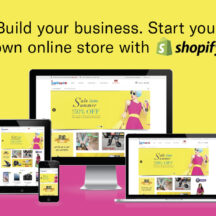10 essential steps to grow your business online
The pandemic changed the reality of many different aspects of people’s lives. One of the biggest shifts of behaviour happened in the way that people shop and work. The ability to operate remotely is now crucial to businesses. But, it can be an intimidating process to work out how to grow your business online.
We’ve put together our top 10 tips to help you successfully digitise your business. Read on to find out how to grow your business online.
1. Assess your offering
If you’re currently running a business that works solely or mostly offline, you need to start by considering how online service is going to help you and your customers. Is it possible that you may be able to offer more of the services or products you currently offer in-person, online? If not, then it might be that going online can create a much more efficient lead generation machine than you currently have.
For example, if you’re a business consultant, could you offer live webinars to groups of your target audience? Could you then charge for 1-on-1 sessions delivered via video conferencing? Or, could you move your retail store on to an eCommerce platform?
Whatever it is, review your current business model, and work out how going online can help you deliver more work or products to your target audience.
2. Set up a website
Ok, so you might have expected this to be the first step. Whilst this sounds obvious, it’s important to fully understand what you’re going to need a website for and work out the user journey for users that come to you online. Are you looking for leads? Are you looking to sell directly to the customer? Or are you just looking to have a space where customers can find out more about you? All of these reasons are valid.
What skills do you need to get your website built? You may need to hire a website designer and hire a web developer. If you’re no Shakespeare, then you might want to also consider hiring a copywriter as well. Other options such as a photographer or video editor might also come in handy if you’re looking to build a truly professional website with original visuals and/or high-quality product photography.
For certain industries, it may be best to look at developers with specific skills. For example, if you are looking to set up an e-commerce site, then you’ll want a developer with experience on platforms such as Shopify, Magento or Woocommerce. Check out our pool of Shopify web developer talent and Woocommerce freelancers for example.
3. Join a platform
It’s not just about your own website though. There are platforms available for almost any type of industry where potential clients or customers can more easily find you. Some of the more well-known options are Deliveroo or Uber Eats for food delivery if you are a restaurant owner, or Amazon, eBay and Etsy for the retail industry.
There are many options across all industries. Do your research and see what options you have available to you.
4. Set up social media accounts
Setting up social media accounts can be a great way of engaging with existing clients, but social media doesn’t just need to be an engagement tool. There are also options such as Facebook and Instagram Shop that can help you convert sales directly through your social media account. Explore all of the options you have available and build a social media strategy that can both engage and convert.
Don’t want to spend your days managing social media accounts? You can always hire a freelance social media manager so that you can focus on the bigger picture.
5. Set up a Google My Business page
Setting up a Google My Business page can be a great way for people to find you in your local area, even if they don’t necessarily need to physically come into your office/shop.
Your Google My Business page will come up in the Google Maps app, but can also be found through normal Google search, so this is a great opportunity for you to share more information about your business including opening hours and services you offer to an engaged audience.
6. Encourage reviews
Your existing customers know you provide a top-quality service, so let them do your marketing for you. Across all industries, most potential customers will always check reviews of your service before they commit to buying from you.
Ask loyal customers to leave you a review on websites such as Google or Trustpilot. This is the perfect way to build trust and help push that crucial sale over the line.
7. Create an SEO strategy
If you’ve followed the steps so far, you’ve probably done a pretty good job of building an online business. However, it’s now about optimising your online presence so that you can be found by potential customers. SEO (Search Engine Optimisation) is crucial in helping you achieve this.
A smart SEO strategy that exploits gaps in content competition and includes the key elements of technical SEO can be a really cost-efficient way to send your brand soaring to the top of Google and increase traffic to your site.
One good place to start is by doing keyword research. This involves gathering a database of keywords related to your brand that your target audience might be searching for. One of the key data points here is “search volume”, a metric used by a number of tools to indicate how many monthly searches there are on specific keywords, which can be filtered by region and device among other things. Be sure to focus on mid and long-tail keyword strings that aren’t swamped in competition. If you’re the owner of a candle e-store, for example, you’re much better off targeting keywords like “artisan homemade candles” rather than simply “candles”.
Comprehensive keyword research can inform a killer long-term content strategy as well as key on-page SEO mark-ups such as page titles, header tags, alt tags and general keyword usage throughout your content. There are plenty of tools out there to help you with this, many of them free, such as Wordtracker and Keyword Tool, though you may want to consider hiring an SEO expert too.
8. Trial digital advertising campaigns
Digital advertising can be a great way to introduce new customers to your brand. If you’re willing to put a bit of budget behind your marketing activities, you can start seeing results very quickly. The beauty of digital advertising is that, if set up correctly, you can track how well they perform much easier than offline marketing.
To get started, the best options are probably Google Search and Facebook. These are relatively simple to set up some basic campaigns, and they are often the most effective for conversion. If you find these successful and want to go more in-depth, it could be worth looking at taking some of the free courses that Google provides in their Skillshop.
Alternatively, you could look at hiring a digital marketing freelancer.
9. Email marketing
Hopefully, by now, you should have a successful online business. Now you need to nurture the customers that you already have. Email marketing can be a great way to do this and contribute towards a positive ROI, particularly for smaller businesses. Keep your customers loyal and engaged with communications that are convenient, personal, and relevant.
The first step is to choose the right email service provider to carry out your CRM communications. Popular choices for small businesses include Hubspot and Mailchimp. You can start simply by just sending a monthly newsletter with engaging content from your blog or social media pages.
To really increase your ROI through CRM, you may want to look at creating automated workflows. By segmenting your customers and learning their behaviour, you can help convert them by hitting them with relevant content at the right time.
If this sounds a little bit daunting, then start small and work your way up. To create a truly optimised CRM strategy, you should consider hiring a CRM expert who can manage technical tasks and ensure best practices across your email marketing activities.
10. Explore retargeting methods
Retargeting is an intelligent way of trying to re-engage visitors to your website. As an example, someone may have come to your site to look at your products or services, but decided not to go ahead with the conversion. Retargeting allows you to serve adverts related to the page they were previously looking at and invite them back to your website, where hopefully they may convert.
As you might expect, Google is the leader and pioneer in this field, so it is worth starting with the Google Display Network. There are many other options available though, so if you think it’s worth exploring, do your research and see which formats might work best for you.
If you are looking to set up more sophisticated campaigns, you may want to look at hiring a professional.
Think we’re missing something? Let us know your top tips by emailing community.comms@peopleperhour.com













